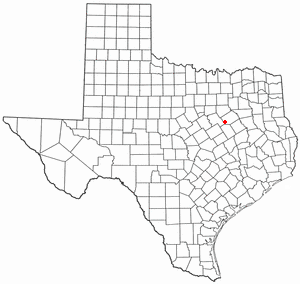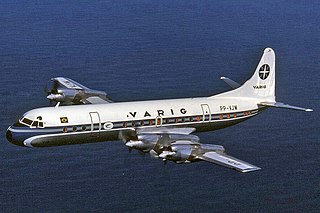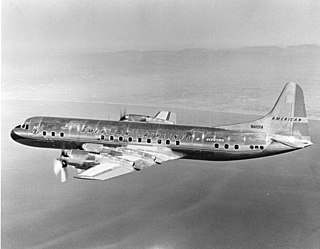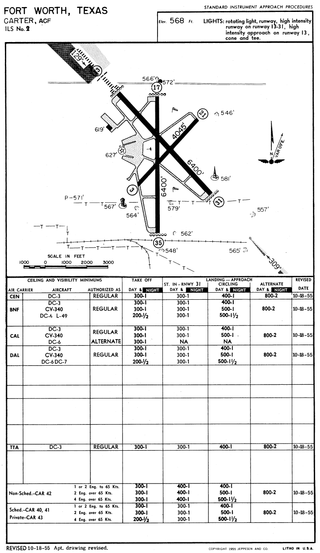
Dawson is a town in Navarro County, in the U.S. state of Texas. The population was 807 at the 2010 census.

Delta Air Lines Flight 191 was a regularly scheduled Delta Air Lines domestic service from Fort Lauderdale, Florida, to Los Angeles with an intermediate stop at Dallas/Fort Worth International Airport (DFW). On August 2, 1985, the Lockheed L-1011 TriStar operating Flight 191 encountered a microburst while on approach to land at DFW. The aircraft impacted ground just over one mile (1.6 km) short of the runway, struck a car near the airport, collided with two water tanks, and disintegrated. 137 people died and 25 others were injured in the crash. The National Transportation Safety Board (NTSB) determined that the crash resulted from the flight crew's decision to fly through a thunderstorm, the lack of procedures or training to avoid or escape microbursts, and the lack of hazard information on wind shear. Forecasts of microbursts improved in the following years, with USAir Flight 1016 being the only subsequent microburst-induced crash of a commercial, fixed-wing aircraft in the United States as of 2024.

Delta Air Lines Flight 1141 was a scheduled domestic passenger flight between Dallas/Fort Worth, Texas and Salt Lake City, Utah. On August 31, 1988, the flight, using a Boeing 727-200 series aircraft, crashed during takeoff, resulting in 14 deaths and 76 injuries of the 108 on board.

The Lockheed L-188 Electra is an American turboprop airliner built by Lockheed. First flown in 1957, it was the first large turboprop airliner built in the United States. Initial sales were good, but after two fatal crashes that led to expensive modifications to fix a design defect, no more were ordered. With its fairly high power-to-weight ratio, huge propellers and very short wings, large Fowler flaps which significantly increased effective wing area when extended, and four-engined design, the airplane had airfield performance capabilities unmatched by many jet transport aircraft even today—particularly on short runways and high altitude airfields. Jet airliners soon supplanted turboprops for many purposes, and many Electras were modified as freighters. Some Electras are still being used in various roles into the 21st century. The airframe was also used as the basis for the Lockheed P-3 Orion maritime patrol aircraft.

Pan Am Flight 759 was a regularly scheduled domestic passenger flight from Miami to San Diego, with en route stops in New Orleans and Las Vegas. On July 9, 1982, the Boeing 727 flying this route crashed in the New Orleans suburb of Kenner after being forced down by a microburst shortly after takeoff. All 145 on board, as well as eight people on the ground, were killed.

American Airlines Flight 320 was a scheduled flight between Chicago Midway International Airport and New York City's LaGuardia Airport. On February 3, 1959, the Lockheed L-188 Electra performing the flight crashed into the East River during its descent and approach to LaGuardia Airport, killing 65 of the 73 people on board. Weather conditions in the area were poor, which meant that the crew had to descend through dense clouds and fog. The aircraft flew lower than the pilots intended and it crashed into the icy river 4,900 feet (1,500 m) short of the runway at a speed of 140 knots. American Airlines had been flying the newly-developed Lockheed Electra in commercial service for only about two weeks before the accident.

Greater Southwest International Airport, originally Amon Carter Field (ACF), was the commercial airport serving Fort Worth, Texas, from 1953 until 1974. Dallas/Fort Worth International Airport opened in 1974 a few miles north to replace Greater Southwest and Dallas Love Field as a single airport for the Dallas-Fort Worth Metroplex. The area is now a commercial/light-industrial park serving DFW International, centered along Amon Carter Boulevard, which follows the old north-south runway.
Northwest Airlines Flight 2 was a Lockheed Super Electra aircraft, registration NC17388, which crashed into the Bridger Mountains in Gallatin County, Montana, about twelve miles (20 km) northeast of Bozeman, on January 10, 1938. All ten on board were killed in the accident, which was the first fatal crash of a Lockheed Super Electra and of a Northwest Airlines aircraft.

Braniff International Airways Flight 250 crashed near Falls City, Nebraska, on August 6, 1966, en route to Omaha from Kansas City, Missouri. Thirty-eight passengers and four crew members were killed in the crash, which occurred in a farm field late on a Saturday night. In-flight structural failure due to extreme turbulence in an avoidable weather hazard was cited as the cause.

Southern Airways Flight 242 was a flight from Muscle Shoals, Alabama, to Atlanta, Georgia, with a stop in Huntsville, Alabama. On April 4, 1977, it executed a forced landing on Georgia State Route 381 in New Hope, Paulding County, Georgia, United States, after suffering hail damage and losing thrust on both engines in a severe thunderstorm.

LANSA Flight 508 was a Lockheed L-188A Electra turboprop operated as a scheduled domestic passenger flight by Lineas Aéreas Nacionales Sociedad Anonima which crashed in a thunderstorm en route from Lima to Pucallpa in Peru on 24 December 1971, killing 91 people — all six of its crew and 85 of its 86 passengers. It is the deadliest lightning strike disaster in aviation history.

Mohawk Airlines Flight 411, a Fairchild FH-227B twin-engine turboprop, registered N7811M, was a scheduled domestic passenger service operated by Mohawk Airlines, between Albany and Glens Falls, New York. On November 19, 1969, it crashed into Pilot Knob Mountain, killing all 14 passengers and crew on board.

Progress Multi Trade Air Flight 241 was a scheduled domestic passenger flight from Siem Reap to Sihanoukville, Cambodia. The flight was operated by regional airliner PMTair using an Antonov An-24. On 25 June 2007, the Antonov An-24, registered as XU-U4A, disappeared over the Cambodian jungle near Bokor Mountain in Kampot while on approach to Sihanoukville. A massive search and rescue operation ensued with thousands of soldiers and police scoured the area. The aircraft was found to have crashed in southwestern Cambodia, northeast of Dâmrei Mountains. All 22 people on board, most of whom were South Korean tourists, were killed. It remains as the second deadliest air disaster in Cambodian history.

Braniff International Airways Flight 542, a Lockheed L-188 Electra, registration N9705C, was a scheduled domestic flight from Houston, Texas, bound for New York with scheduled stops in Dallas and Washington, D.C. On September 29, 1959, 23 minutes into the 41-minute flight from Houston to Dallas Love Field, the aircraft disintegrated in mid-air approximately 3.8 miles (6.1 km) southeast of Buffalo, Texas, killing everyone on board.

Bhoja Air Flight 213 was a domestic scheduled passenger flight operated by Pakistani airline Bhoja Air from Karachi to Islamabad. On 20 April 2012, the Boeing 737-236A aircraft serving the route crashed in bad weather during its final approach to land. All 121 passengers and 6 crew members aboard were killed. With 127 deaths, it remains as the second deadliest air disaster in Pakistan.

On May 30, 1972, Delta Air Lines Flight 9570 crashed while attempting to land at the Greater Southwest International Airport (GSW) in Fort Worth, Texas during a training flight. All four occupants aboard the training flight were killed. The crash was determined to be caused by the aircraft flying through wake turbulence, and led to sweeping changes in procedures for maintaining minimum safe distance behind aircraft that generate substantial wake turbulence.

Air Manila Flight 702 was an unscheduled passenger flight from Naval Air Station Agana in Guam to Ninoy Aquino International Airport in Manila, carrying 33 passengers and 12 crew members; most of whom were personnel from the base. The Lockheed L-188A Electra attempted takeoff from runway 6L but crashed near a residential area; the crash was caused by retracting the flaps at an altitude too low to clear the terrain after the propeller of engine number three feathered. All 45 people on board and one person on the ground perished in the crash. The investigation concluded that the pilot should have followed company policy by aborting takeoff in the event of an engine failure before reaching VR (takeoff) speed.

Ryan International Airlines Flight 590 was a cargo flight carrying mail for the United States Postal Service from Greater Buffalo International Airport (BUF) in Buffalo, New York, to Indianapolis International Airport (IND) in Indiana, with a stopover at Cleveland Hopkins International Airport (CLE) in Cleveland, Ohio. On February 17, 1991, the McDonnell Douglas DC-9-15RC operating the flight crashed on takeoff from Cleveland during icing conditions. Both pilots, the aircraft's only occupants, were killed. The National Transportation Safety Board (NTSB) determined that the causes of the crash were the flight crew failing to deice their aircraft, and the inexperience of the Federal Aviation Administration (FAA), McDonnell Douglas, and Ryan International Airlines with icing condition on DC-9-10 aircraft.

The crash of Delta Air Lines Flight 318 was an accident involving a Douglas DC-3 of the American airline Delta Air Lines 13 miles (21 km) east of Marshall, Texas, United States on May 17, 1953, killing all but one of the 20 people on board.

















